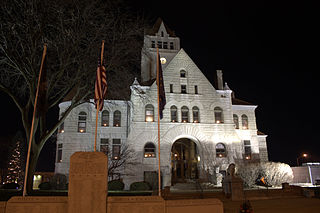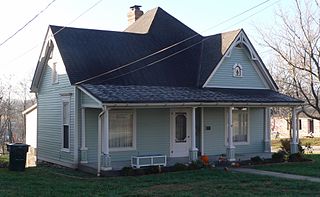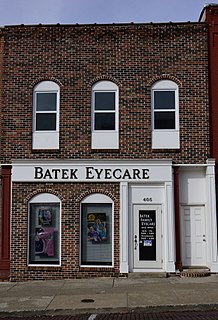
Fulton is the largest city in and the county seat of Callaway County, Missouri, United States. Located about 22 miles (35 km) northeast of Jefferson City and the Missouri River and 20 miles (32 km) east of Columbia, the city is part of the Jefferson City, Missouri, Metropolitan Statistical Area. The population was 12,790 in the 2010 census. The city is home to two universities, Westminster College and William Woods University; the Missouri School for the Deaf; the Fulton State Hospital; and the Fulton Reception and Diagnostic Center state prison. Missouri's only nuclear power plant, the Callaway Plant is located 13 miles southeast of Fulton.

Westminster College is a private college in Fulton, Missouri. It was established in 1851 as Fulton College. America's National Churchill Museum is a national historic site located on campus. The school enrolled 609 students in 2020.
The Confederate Memorial State Historic Site is a state-owned property occupying approximately 135 acres (55 ha) near Higginsville, Missouri. From 1891 to 1950, the site was used as an old soldiers' home for veterans of the Confederate States Army after the American Civil War. The Missouri state government then took over operation of the site after the last veteran died in 1950, using it as a state park. In 1981, a cottage, a chapel, and the Confederate cemetery were listed on the National Register of Historic Places as the Confederate Chapel, Cemetery and Cottage. The chapel was moved from its original position in 1913, but was returned in 1978. It has a tower and a stained glass window. The cottage is a small wooden building, and the cemetery contains 723 graves. Within the cemetery is a monument erected by the United Daughters of the Confederacy which is modeled on the Lion of Lucerne. In addition to the cemetery and historic structures, the grounds also contain trails, picnic sites, and fishing ponds.

Samuel Sloan was a Philadelphia-based architect and best-selling author of architecture books in the mid-19th century. He specialized in Italianate villas and country houses, churches, and institutional buildings. His most famous building—the octagonal mansion "Longwood" in Natchez, Mississippi—is unfinished; construction was abandoned during the American Civil War.

The Isaac Bell House is a historic house and National Historic Landmark at 70 Perry Street in Newport, Rhode Island. Also known as Edna Villa, it is one of the outstanding examples of Shingle Style architecture in the United States. It was designed by McKim, Mead, and White, and built during the Gilded Age, when Newport was the summer resort of choice for some of America's wealthiest families.
Bell House or Bellhouse may refer to:

The Bennink-Douglas Cottages are a collection of four historic worker duplexes in Cambridge, Massachusetts. Built in 1874 as a speculative venture, they typify the housing built for low and middle-income workers in the 1870s. They were listed on the National Register of Historic Places in 1986.

The Fulton County Courthouse is a historic courthouse located at Rochester, Fulton County, Indiana. It was built in 1895–1896, and is a four-story, Richardsonian Romanesque style limestone building. It has a cross-hall plan and features a central bell and clock tower with a pyramidal roof. In addition to the courthouse, the grounds have four memorials: one for the Pottawatomies' Trail of Death, a cornerstone for the Rochester College, and two war memorials.

The Corbin Building is a historic office building at the northeast corner of John Street and Broadway in the Financial District of Manhattan in New York City. It was built in 1888–1889 as a speculative development and was designed by Francis H. Kimball in the Romanesque Revival style with French Gothic detailing. The building was named for Austin Corbin, a president of the Long Island Rail Road who also founded several banks.

The Brandon-Bell-Collier House is a house in Fulton, Callaway County, Missouri, in the state of Missouri in the central United States. It was built in stages between about 1862 and 1917. From 1900 to 1902, it was owned by Fulton architect Morris Frederick Bell, who undertook a major remodelling, expanding the house to two stories and incorporating elements of the Queen Anne and Colonial Revival architectural styles.
The Thomas Hickman House is a historic home in Howard County, Missouri. It is a brick, Georgian-style house, built by businessman Thomas Hickman in 1819. It was added to the National Register of Historic Places in July 2006.

The Cottage Home Historic District is a historic district and neighborhood located on the near east side of Indianapolis, Indiana. A small portion of Cottage Home is listed on the National Register of Historic Places while a larger area is listed on the state and local levels. Known for its preponderance of "cottage-style" homes built with strong Victorian influences, Cottage Home has historically been a working class neighborhood. Numerous industrial buildings are also scattered throughout the district, providing a base of economic activity. Today, however, many of these buildings are vacant, providing a special challenge to preservation and urban renewal efforts.
Morris Frederick Bell was an American architect known primarily for his institutional buildings but also for his domestic and commercial structures. His best known work is the David R. Francis Quadrangle the historic center of the University of Missouri including Jesse Hall. He also designed state correctional schools in Boonville, Chillicothe, and Tipton; and state mental hospitals in Fulton, Higginsville, and Nevada. Bell, a democrat, was also active in civic life, especially Masonic organizations. He trained and employed William Lincoln Garver as an assistant. Garver would later go on to have a stand-alone career.

The Robison House in Sparks, Nevada, at 409 13th St., is a historic mansion-like house with Colonial Revival elements built c. 1904. The property includes small rental cottages used in Reno, Nevada's "divorce trade". It is listed on the National Register of Historic Places (NRHP).

Grand Mound Town Hall and Waterworks Historic District, also known as Hose house, pump house, is a historic district located in Grand Mound, Iowa, United States. It was listed on the National Register of Historic Places in 2001. The district is composed of two buildings and the town's water tower.

The Fred and Rosa Fulton Barn is a historic building located north of Selma, Iowa, United States in rural Jefferson County. The barn was built by Rosa from plans prepared by the Louden Machinery Company of Fairfield, Iowa. It is a good example of the company's Gothic laminated roof design. The barn also includes other Louden-manufactured devices, including "Master-Made" ventilator windows, metal roof aerators, hay carrier and fork, and door tracks and trolleys. This equipment is original to the barn's construction in 1947. Built for a dairy operation, the structure has subsequently been used for general farm purposes. The barn was listed on the National Register of Historic Places in 1999.

M. Fred Bell Rental Cottage is a historic home located at Fulton, Callaway County, Missouri. It was built between about 1893 and 1894, with additions designed by Fulton architect Morris Frederick Bell built about 1904. It is a one-story, Queen Anne / Shingle Style frame cottage with a central hip roof with pinwheel projecting gables. It was restored in the late-1990s.

Dr. George M. Willing House, also known as the Fleming Home and Joseph Denton Home, is a historic home located at Fulton, Callaway County, Missouri. It was built about 1855, and is a two-story, five bay, Greek Revival style brick dwelling. It has a side gable roof and features six colossal pilasters which divide the front facade and a massive hand carved solid walnut circular stairway in the front-entrance hall.

Downtown Fulton Historic District is a national historic district located at Fulton, Callaway County, Missouri. It encompasses 57 contributing buildings and 1 contributing structure in the central business district of Fulton. It developed between about 1877 and 1954, and includes representative examples of Italianate, Second Empire, Colonial Revival, and Classical Revival style architecture. Some of the buildings were designed by noted local architect Morris Frederick Bell. Notable buildings include the Southern Bank of Fulton, Masonic Lodge (1872), Home Savings Bank, Montgomery-Bell Dry Goods, Humphreys-Atkinson-Reid Furniture Company, Fulton Cinema (1926), Kingdom Oil Company (1937), First Christian Church (1911), Adams Building (1890), and U.S. Post Office (1915).

Court Street Historic Residential District is a national historic district located at Fulton, Callaway County, Missouri. It encompasses 84 contributing buildings in a predominantly residential section of Fulton. It developed between about 1844 and 1945, and includes representative examples of Queen Anne, Second Empire, Colonial Revival, American Foursquare, and Bungalow style architecture. Some of the buildings were designed by noted local architect Morris Frederick Bell. Located in the district is the separately listed Brandon-Bell-Collier House. Other notable buildings include the John W. Tucker Residence (1912), Klinginsmith Residence, Synodical College-Seminole Apartments, Synodical College Dormitory-Seminole Apartments (1913), Gish Residence, Dave and Ida McCue House, First Presbyterian Church, Leland Waters Residence, Bauer House, and Martin-Harris House.




















